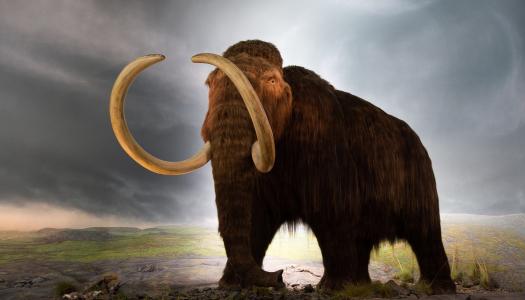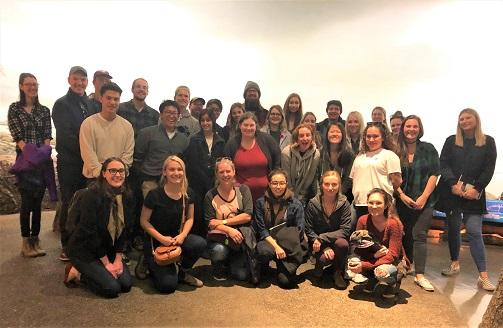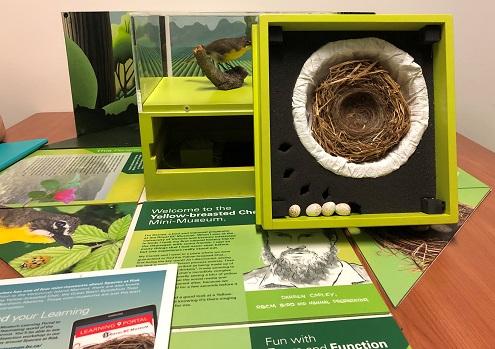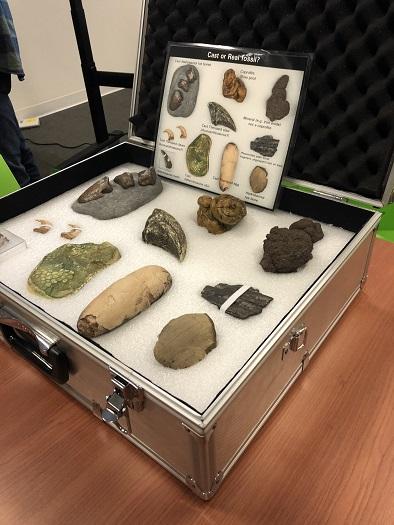ENSC students learn #SciComm at the Royal BC Museum

On Friday, November 1st, students from Environmental Science 308: Foundational Biology and Communications journeyed across the city to the Royal British Columbia Museum (RBCM) for a school visit. As part of the second unit of the communication portion of their course, they were introduced to foundations in museum communication. Since museums have a long history of educating and engaging the public, our visit was intended to show students how museums interpret science and how they curate information for different visitor types.
Our visit began in the Clifford Carl Hall, where we were warmly greeted by Liz and Jenny, Educators and Learning Program Developers. They quickly whisked us away to a classroom where we explored how the RBCM approaches science communication. They also introduced us to the concept of informal learning before detailing interpretive and educational approaches of museums. We even had a chance to explore their beautifully-designed learning portal filled with images, posts, videos, maps, and more.

Students from ENSC 308: Foundational Biology and Communications.
Museum communication, specifically centered on the environment and natural history, often follows 6 principles of interpretation. Developed by Freeman Tilden in 1950s, they were intended to help informal learning sites effectively interpret and communicate historic and scientific information to a diversity of park visitors. Having discussed this during our previous class, I was delighted that Liz and Jenny shared his vision:
- Any interpretation that does not somehow relate what is being displayed or described to something within the personality or experience of the visitor will be sterile.
- Information, as such, is not Interpretation. Interpretation is a revelation based upon the information. But they are entirely different things. However, all interpretation includes information.
- Interpretation is an art, which combines many arts, whether the materials presented are scientific, historical or architectural. Any art is in some degree teachable.
- The chief aim of Interpretation is not instruction, but provocation.
- Interpretation should aim to present a whole rather than a part, and must address itself to the whole [hu]man rather than any phase.
- Interpretation addressed to children (say, up to the age of twelve) should not be a dilution of the presentation to adults, but should follow a fundamentally different approach. To be at its best it will require a separate program.
We then learned about how education in museums is all about creating opportunities for discovery, therefore, interpreters often use the ‘provoke, relate, and reveal’ strategy. This essentially follows the constructivism philosophy of education where learning is viewed as an active process. More traditional educational approaches considered learners as blank sponges, however, this approach helps them actively construct their own meaning based on their existing knowledge and experiences. As an inquiry-based form of learning, this educational approach also relies on the senses

Yellow-breasted Chat Mini Museum Box.
To put this into practice, Liz and Jenny opened a fossil box filled with real and cast specimens. Students also had a chance to look through a species at risk mini museum box, which contained a Yellow-breasted Chat (Icteria virens) along with her nest and eggs. Museum staff send these out into different communities to help teach people about “species at risk in British Columbia, which species are unique to our province, why it is important to care, and what they can do to help”.
Following our classroom session, we headed to the Natural History Gallery where we immediately came across the iconic Woolly Mammoth diorama in the Ice Age display. As mammoths roamed Southern Vancouver Island during the Ice Age, the diorama includes a touchable frozen wall. Much to our surprise, it was actually built using a refrigerator panel! A few paces away, a scannable plaque opens ‘Woolly’s World’. This augmented reality app animated “a slice of Pleistocene life, including the illusion of mammoths in motion”. Using our phones, we could see baby mammoths running across the diorama along with other animals that lived alongside this now extinct species.

Fossil Box
As we ventured deeper into the gallery, Jenny snuck us into a secret room next to the coastal forest display. Once inside, we saw taxidermy wolves, beavers and bears up close. You rarely get the opportunity to touch any artifacts, specimens or displays in exhibits. However, museums recognize that multisensorial experiences are important for visitor learning and experience. As the oils from our palms can damage fur, we carefully stroked animals with the back of our hands.
Students were then set free to explore the rest of the Natural History gallery, which showcases a coastal forest, a seashore, an ocean station, and the Fraser River Delta. They each chose an object, artifact, taxidermy animal, or subject from the gallery to highlight in their next assignment. As it was a Friday afternoon, visiting the museum was a lovely way to top off a busy week, especially since the students had taken a test earlier in the day!